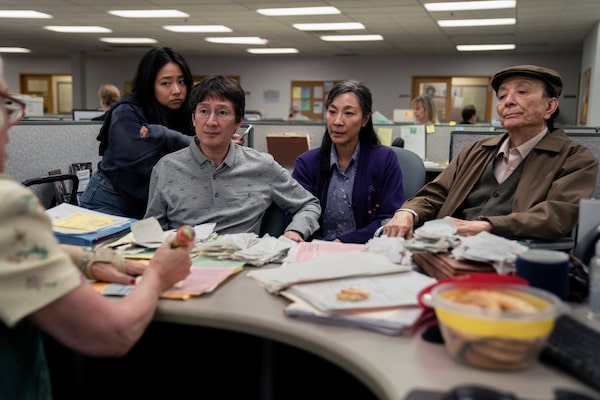
Michelle Yeoh stars in Everything Everywhere All at Once.David Bornfriend/Courtesy of A24 / Elevation Pictures
Everything Everywhere All at Once
- Written and directed by Dan Kwan and Daniel Scheinert
- Starring Michelle Yeoh, Stephanie Hsu and Ke Huy Quan
- Classification R; 132 minutes
- Opening April 1 in Toronto and Vancouver; expands to other Canadian cities April 8
Critic’s pick
The sophomore feature from the writing-directing duo known as the Daniels (Dan Kwan and Daniel Scheinert), Everything Everywhere All at Once is a kinetic and sprawling exercise in mischievously eschewing the boundaries of narrative filmmaking. In many ways a homage to the inimitable grace and talent of its star Michelle Yeoh, the film takes gleeful joy in the experiential potential of limitless cinematic shape-shifting.
Yeoh plays Evelyn Wang, the focused yet harried owner of a laundromat that is in the midst of an audit with the IRS. Her relationships with her loved ones have taken a back seat to these urgent responsibilities and stressors, with her husband, Waymond (Ke Huy Quan), playing a role in the household more akin to befuddled colleague than long-time romantic partner. Evelyn’s daughter, Joy, a twentysomething who is navigating coming out, is likewise de-prioritized within the family orbit and has clearly been feeling as such for far too long. Present, too, is Evelyn’s father, Gong Gong (James Hong), whose disapproval of his daughter’s life choices comes to be the emotional spectre under which the entire family lives.

Stephanie Hsu, Ke Huy Quan, Michelle Yeoh and James Hong in Everything Everywhere All at Once.Courtesy of A24 / Elevation Pictures
What begins as an engaging study of family dynamics (replete with fantastic editing and even more finely choreographed camera work) descends suddenly into a sci-fi action comedy that trades in infinite multiverses and multiple identities. Evelyn learns that she alone can save the world by exploring other universes connecting with the lives she could have led. What follows is a seemingly random narrative generator of worlds wherein chaos, pastiche and a comic sense of self-undoing serve as the sly vehicle through which we are offered the most effortless of moral tales.
It might feel like an attack on the senses, but Everything Everywhere refuses stability, and continually roots and uproots us here, there and, well, everywhere. Whether it’s people with hotdogs for fingers, a hyper-animated dance to the death, or an omnipresent everything bagel that spells the end of life as we know it, the film positions the ordinary as a means for the fantastic. Fanny packs, tubes of ChapStick, and self-induced paper cuts are no longer the humdrum ephemera of the everyday, but a portal into the chimeric and otherworldly.
Abundantly present, too, are the Daniels’ nods to fellow filmmakers (Wong Kar-wai, the Wachowskis, and Michel Gondry emerge most immediately) as well as their own cast members. From the comforting and charming Ke Huy Quan (the former child actor best known as Short Round in Indiana Jones and the Temple of Doom) to the dominating presence of prolific character actor James Hong, or even to the fantastically cast Jamie Lee Curtis as the IRS office drone/villain – never mind the love that the Daniels clearly have for Yeoh’s own on-screen legacy (here riffed on throughout the film) – one of the most satisfying aspects of Everything Everywhere is the self-conscious, and often times meta, positioning of its own characters. The Daniels have created a world that not only explores the infinite universes of its own fiction, but brings in many threads of our reality.
While audiences might try to follow the increasingly unclear plot with a logical lens – the film’s final act feels as if its mania has reached a sort of event horizon where it just can’t be unscrambled – the real delight of Everything Everywhere lies in sitting with the feelings that the movie evokes rather than trying to make sense of it all. It is a film that asks audiences to take the plunge into chaos and confusion, so that we’re able to fully see the innate humanity of what remains when the dust of it all settles.
Special to The Globe and Mail
Plan your screen time with the weekly What to Watch newsletter. Sign up today.